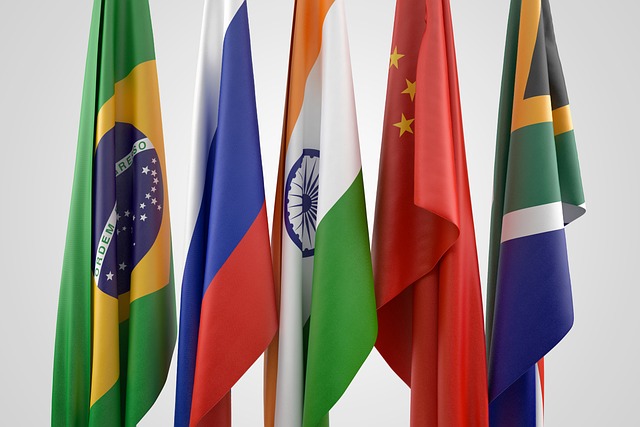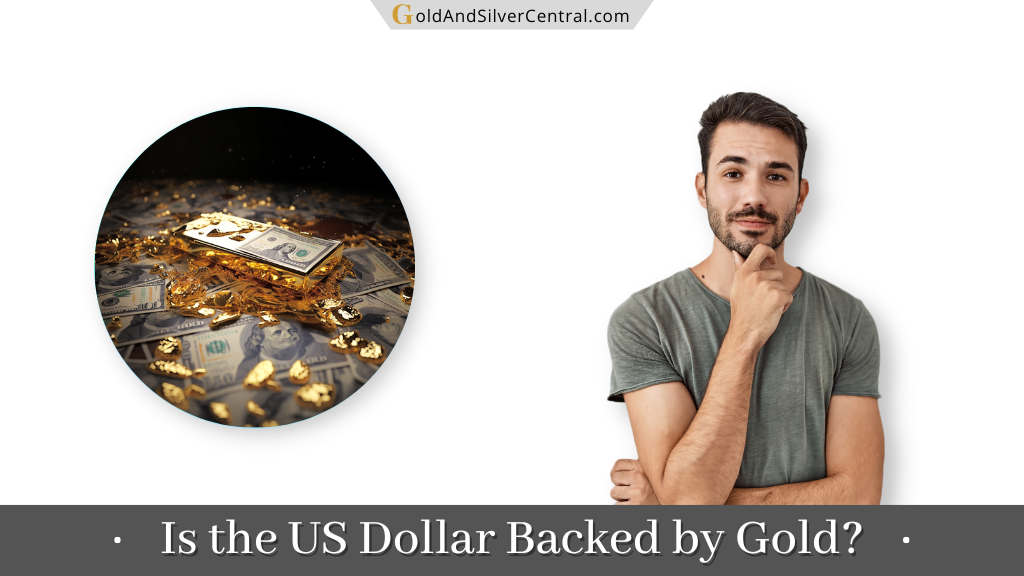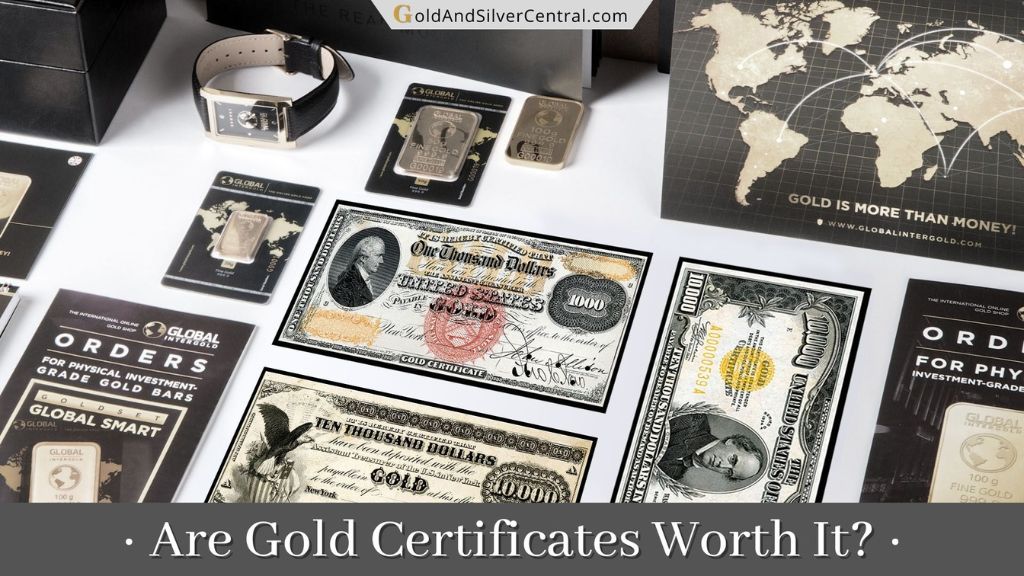Ever wondered:
What is money backed by? Is the U.S. dollar backed by gold? What happens with our currency with the rise of BRICS bucks?
You’re not alone.
It’s some of the commonly asked questions when it comes to currency, our economy, fiat money, and precious metals.
And that’s exactly what we’ll cover today.
Specifically:
- The abandonment of the gold standard
- Bretton Woods agreement
- The present condition of the U.S. dollar
- De-dollarization and the new international currency
- Lots more
Without further ado, let’s start with history of the United States dollar.
Is U.S. Currency Still Backed By Gold?
First things first:
The Federal Reserve notes are no longer redeemable in silver, gold, or any other commodity.
When it comes to the yellow precious metal, this came into effect in 1934 with the changes in the Federal Reserve Act made by the Congress:
“The said [Federal Reserve] notes shall be obligations of the United States…
They shall be redeemed in lawful money on demand at the Treasury Department of the United States, in the city of Washington, District of Columbia, or at any Federal Reserve bank.”
As for the silver, it stopped being redeemable since the 1960s.
But let’s talk a bit more about the gold standard, what it was exactly, and why they started abandoning it.
Abandoning The Gold Standard
Look:
There was a time when every buck in your pocket was as good as gold. This is when the countries decided their money should be worth its weight in this yellow metal.
Sweet, right? Real money, not just some IOU from the government.
The gold standard, as they called it, was all the rage. It made trading between countries smoother than a well-made milkshake.
But life isn’t a walk in the park, and gold isn’t limitless. So, when the economy went belly up, governments had their hands tied.
Then the ’30s rolled in, bringing the Great Depression, which had a worldwide impact.
Governments needed to kick-start their economies, but this gold standard was like a straitjacket and they started abandoning it.
In the United States, the gold standard was abandoned when President Roosevelt signed the Gold Reserve Act of 1934.

This was the time when the government started to restrict private precious metal ownership and how much gold an American citizen can own.
Skip to 1944 and the Bretton Woods Agreement.
The dollar became the king of currencies, tied to this precious metal, while others hitched a ride with it. (Stay tuned for that part.)
Zoom into the ’70s, and President Nixon has a plot twist.
No more swapping dollars for gold. And just like that, fiat currency got the spotlight.
Now, the value of money was all about trust. Trust in the government, not a shiny rock.
With the fiat governments could play around more, but there was a catch. They had to keep an eye on inflation, or their money could end up as valuable as Monopoly dough.
Quite a tricky task, might we add.
Bretton Woods Agreement
After World War II left the world’s economy in a jumble, the big shots devised a new game plan.
They didn’t want a repeat of the economic missteps that led to the Great Depression.
So what they came up with was the Bretton Woods Agreement, named after the New Hampshire town where they hashed it all out in 1944.

This is when the U.S. dollar was picked to be the world’s go-to reserve currency.
Everyone else pegged their money to this currency, and in return, the dollar was tied to gold at a flat rate of $35 an ounce.
This gave us a set of fixed exchange rates, making international trade and investment a little less like rolling the dice.
The Bretton Woods system also led to the birth of the International Monetary Fund (IMF) and the World Bank.
The IMF’s job was to keep an eye on the international money situation, and the World Bank was there to help countries left in shambles after the war to rebuild and grow.
Gold was the VIP of the Bretton Woods system.
It was the solid ground for international currencies. Central banks kept their currencies in line with the U.S. dollar by trading in the foreign exchange markets.
If their currency started to look a bit weak compared to the dollar, they’d step in and sell off their own currency for dollars, which they could still swap for gold.
This kept exchange rates stable and gave people confidence in international money matters.
As time passed and the global economy changed, the Bretton Woods system started to show some wear and tear. It hinged on the U.S. keeping dollars convertible to the shiny yellow metal.
But then important changes took place in history…
The Nixon Shock and the End of the Gold-Backed Dollar
As it was mentioned earlier, the Bretton Woods agreement started to show some wear and tear.
The thing is that from the ’60s, the United States dealt with problems like rising inflation and a trade deficit due to spending on the Vietnam War and domestic social programs.
They were pumping out more dollars without the precious metal to back it up.
By the early ’70s, faith in the U.S. currency and its gold convertibility was shaking.
Governments and investors overseas were swapping their dollars for gold fast, stressing the country’s gold reserves.
In response, President Nixon decided on August 15, 1971, to cut ties with this standard.

This move, known as the “Nixon Shock,” was the final break between the American dollar and the yellow metal, and it marked the end of the Bretton Woods system.
It was a real curveball, a reaction to huge problems like inflation, trade issues, and the gold reserves getting a serious workout.
And wow, did it shake things up!
Not just for the U.S. but for the whole wide world. We said goodbye to the Bretton Woods system and hello to flexible exchange rates.
Things got a lot more volatile in currency markets, and that spun global trade and finance on its head.
From that point, the dollar had to stand alone—no more precious metal to back it up.
Its new superpower? Trust.
Yup, trust from people and the government.
No longer was the dollar’s worth about how much yellow metal we had stashed away, but how tough the U.S. economy was and how smart we were with our money moves.
Sure, it gave central banks some new tricks. They could control the money supply and interest rates, letting them better roll with the economy’s punches.
But they had to be careful. More power meant more chances to muck things up, like causing wild inflation or deflation.
This all got people really heated.
Some were convinced the dollar was headed for inflation since no gold was holding us back from just running the printers. They thought people would lose faith in the long-term stability of the dollar.
But others were fist-pumping at the idea of a fiat system.
They reckoned dropping the precious metal standard was like kicking off the training wheels. It meant the U.S. could flex and pivot to boost economic growth and stability, not just hoard gold.
By the way, share your thoughts in the comments below, does US currency have to be backed by gold, or do you think the fiat system works better?
Status of the U.S. Dollar & The BRICS
Historically speaking:
Even with the gold standard in the rearview mirror and the whole Nixon Shock, the American dollar for a very long time was the big cheese of world currencies.

Until recently, about two-thirds of global foreign exchange reserves are made up of USD, and it was the go-to currency for most international deals.
Even something as big as oil was priced in dollars. This wide usage has cemented it as the backbone of international money matters.
A lot of it came down to trust.
The U.S. economy is a powerhouse, with solid institutions and laws backing it up. That used to make it a safe bet.
Plus, the country’s financial markets are like a beacon for investors across the globe, offering stability and easy trading. It tends to shine even brighter when the global economy hits rough waters.
Having the global reserve currency is like having a golden ticket for the U.S.
It means that its government can borrow money at lower interest rates because everyone wants to buy U.S. Treasury bonds.
And it gives the United States a top seat at the table in international trade and finance, allowing them to shape big decisions in the global economy.
For other countries, having U.S. dollars in their piggy bank could be a real lifesaver in tough times.
And since many important goods are priced in dollars, countries can use their reserves to buy what they need, smoothing out international trade.
But it’s not all sunshine and rainbows.
Some people think it’s time for a new global reserve currency.
They reckon the U.S. having the top dog currency gives them a bit too much clout, and there are worries they might overstep.
And seems that, indeed, this is happening.
Today, the U.S. faces its greatest challenge to the global economic dominance we’ve taken for granted for the last 80 years.
Five nations representing 40% of the world’s population and one third of the world’s GDP – Brazil, Russia, India, China, South Africa, or the BRICS for short – are planning to launch a new, international form of money fully backed by gold.

The rise of BRICS currency means the shift away from dollar as default, and therefore the United States will lose its position as the world’s number 1 leader.
And that’s not fake news.
Russia and China now mostly trade in roubles or yuan; Malaysia has proposed a pan-Asian gold-backed currency to replace the dollar; Saudi Arabia is increasing investments in yuan assets.
As you can see, the de-dollarization is already in full swing.
Now, what can we say about the gold today?
The Role of Gold in Modern Economics
So, we’ve swapped the gold standard for other systems, but that doesn’t mean we’ve kicked it to the curb.
This yellow metal is still a hot ticket item in the world of finance. See, when the economy is wobbly, or markets are throwing a tantrum, people tend to cozy up with it.
They see it as a safety net against inflation and currency going down the tubes.
It has this reputation because it’s rare, and you can actually get your hands on it. It’s a kind of comfort blanket in crazy economic times.
In the face of financial turbulence, governments and central banks have been known to stockpile a bit more gold.
It’s like their way of playing it safe – diversifying their resources, reducing the chance of getting burned by currency risks, and having a buffer against any financial curveballs.
Even though there’s no formal tie to the standard anymore, central banks around the globe still have their vaults stacked with this shiny metal.
It’s kind of like their secret weapon for shaping monetary policies and keeping the financial boat steady.
It also gives them street cred with international investors, showing they’re serious about managing their economies wisely.
And it’s not just about keeping what they’ve got.
Some central banks are always on the hunt to bulk up their yellow metal reserves. That’s usually the game plan when trust in the home currency wanes, or they want to spread their bets.
Buying more of gold can be a clever move to beef up the country’s financial defenses and guard against any economic weak spots.
Even without the standard, this precious metal is still a big player in finance.
It’s bought and sold left, right, and center by investors, big institutions, and regular Joes to speculate on its value or mix up its investment portfolios.
And it’s important not only on the financial scene.
Gold is also a star in industries like jewelry, electronics, and aerospace because it has some convenient properties. Its demand in these areas adds another string to its economic bow.
Is the U.S. Dollar Backed by Gold?
So…
Is U.S. currency still backed by gold?
Well, not anymore.
Even though we said goodbye to the gold-backed dollar, this currency is became mighty in the global reserve currencies.

Gold also remained a key player in the economic game, holding its own in the world of finance.
It’s the golden child when people want to guard against inflation and shaky currencies. It’s still a staple in investment portfolios and central banks’ stashes.
Without a doubt, its intrinsic value and the role it plays across different sectors continue to make it economically valuable.
The interesting part is that this yellow precious metal is going to be even more valuable with the rise of BRICS, the new international reserve currency fully backed by gold.
Today we see de-dollarization and the shifting power between the USA and the BRICS countries.
At the end of the day, the dance between them is a testament to the delicate balance of economic stability, adaptability, and trust.
The world of finance is always on the move, changing and adapting.
And you can bet your bottom dollar (or your gold nugget) that their roles in shaping what comes next will spark debates and investigations.
And what do YOU think? Let’s debate in the comments below!



